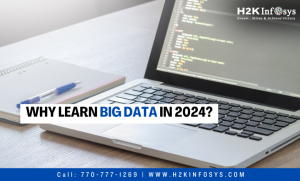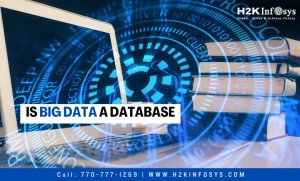Big Data is a term for complex and large datasets, but not just. Big Data is what organizations do with the data. We can analyze data for insights that will lead to better decisions and strategies for business. A relational database cannot handle a huge amount of data, therefore special tools and methods are used to perform operations on big data. Processing of Big data helps companies to understand their businesses better. We can get meaningful information even from raw and unstructured data.
The concept of big data started to evolve in the early 2000s. The industry analyst Doug Laney formulated the first definition of big data as the three V’s:
Volume means that amount of data matters. Big data is about processing high volumes of low-density and unstructured data. We can use data of unknown value. For example, Facebook data feeds, clickstreams on a webpage, data from sensor equipment. the size of data depends on an organization. For one it can be tens of terabytes of data, for others – hundreds of petabytes.
Velocity is the fast rate of receiving the data and usually a fast rate of acting on. The highest velocity is about processing data in memory, not about being written to disk. It is about smart products that can operate in real-time or near real-time and about products that require real-time evaluation and action.
Variety is about the many types of data that are available. We can put traditional data types in a relational database and have a good structure. But in the case of big data, data comes in new unstructured data types. It can be unstructured or partially structured data types, such as text, audio, and video. They require additional preprocessing to get meaning and support metadata.
Two more Vs was added after the past few years. They are value and veracity.
Data usually can have a different value. And it is valuable to discover the value. Also, it is equally important to know how true is your data and how much can you rely on it.
Big Data becomes really important nowadays especially for some of the world’s biggest tech companies. They consume data from previous periods o build a better business and to give better value. They are constantly analyzing data to produce more efficiency and develop new products. One of the last technological breakthroughs reduced the cost of data storage and compute a lot and made it less expensive and easier to store. The volume of big data increased and now is it cheaper and more accessible. We can make more accurate and precise business decisions.
When we talk about finding value in big data, it is not only about analyzing it. This process is about an entire discovery that requires insightful analysts, business users. It is important to ask the right questions, recognize patterns, make informed assumptions, and predict behavior.
Big Data Use Cases
Big Data is widely used in Product Development. For example, companies like Netflix and Procter & Gamble are using big data to understand customer demand. They are building predictive models for new products, modeling the relationship between key attributes from past and current products. Analyzing the commercial success of the products helps to understand the best way for the business. Also, P&G company uses data analytics to determine focus groups, for social media, test markets, and launching new products.
One more use case is Predictive Maintenance. Factors that can predict some kind of failures can be deeply buried in structured data. For example, the year, a model of equipment. The same we can say for unstructured data that covers millions of log entries, sensor data, error messages, engine temperature, etc. By analyzing these data we can find out potential issues before the problems happen. Also, organizations can deploy maintenance more cost-effectively and maximize parts and equipment uptime.
We can use data to analyze Customer Experience. We need to have a clearer view of customer experience and it is more possible now than ever before. With Big data, you can gather data from social media, web visits, call logs, etc to improve the user experience and maximize the value. It is great to have a vision of delivering personalized offers, proactively handle issues that customers faced. One more case is Fraud and Compliance. The security question is not just about a few rogue hackers. Sometimes companies can be against entire expert teams. Security requirements are constantly evolving. With Big data, you will be able to identify patterns in data that indicate fraud and aggregate large volumes of information.
Machine Learning is a top and hot topic right now. Growing of Data and Big Data is the reason for its popularity. We can teach machines instead of program them. The availability of big data to train machine learning models makes that possible.
Operational efficiency is the one more use case for Big Data. It is may not always make the news, but big data is having the most impact here. We can analyze and assess production using Big Data, customer feedback, reduce outages, anticipate future demands, improve decision-making with current market demand. The last case that we are going to mention in this article is Drive Innovation. Big data analysis can help you innovate your business by studying interdependencies among humans, institutions, entities. It helps to process and determining new ways to use such insights. By using of data insights you can improve decisions about financial and planning considerations. It will help you to examine trends, implement dynamic pricing. There are endless possibilities with Big Data.
Big data includes 3 key actions: Integrate, Manage, and Analyze.
Integration is about collecting together data from many sources and applications.
How Big Data Works
Mechanisms for traditional data like extract-transform-load do not work for big data. It needs new approaches and technologies to analyze big data sets.
The integration process is about bringing the data, process it, check the formatting, available in a form that you can get started to process it.
Manage. Big data requires storage. It can be in the cloud, on-premises, or both. Data can be stored in any form you want. People mostly choose their storage solution depending on where their data is currently residing. The cloud currently becoming more popular.
Analyze. Your data are working on you when you analyze it and act on your data. It is cool to get new clarity with a visual analysis of your data sets, explore the data to make new discoveries, use machine learning, and artificial intelligence to build data models.
Big Data Best Practices
The first recommendation is to align Big Data with specific business goals. More extensive data sets are good. But very important is to understand how to filter data to understand e-commerce behavior, deriving sentiment from social media and customer support interactions, understanding statistical correlation methods, their relevance for a customer, a product, manufacturing, and engineering data. It is valuable to optimize knowledge transfer and it can be done by a center of excellence. Sharing of knowledge, controlling of oversight, management of project communications can be done by the center of excellence. Overall information architecture maturity in a structured and systematic way is an important thing.
Besides analyzing big data on its own, you will gain better business insights by using big data with the structured data you are already using today together.
The main idea is to add more relevant data points to your analytical summaries. It will lead to better conclusions. For example, it is usually important to distinguishing all customers and only your best customers. The big data analytical processes can be human-based and machine-based. Therefore, structured data will be really helpful in the analysis process. Big data analysis can have different forms and use different methods. It includes statistic analysis, spatial analysis, semantic analysis, and also visualization.
Discovering data meaning is not a straightforward process, especially when we don’t know what we’re looking for. But this is normal and expected. We can experience a “lack of direction” or “lack of clear requirement.” Analysts and data scientists need to work closely with the business. They need to understand the business, key business knowledge gaps, business requirements.
Big Data analysts require access to a lot of resources. They need to perform some experiments and run a big data solution. The company has to organize a well-planned cloud and security strategy to support the needs of data engineers and the changing of requirements.
Big Data Challenges
Big Data is a promising direction, but also it holds a lot of challenges. Firstly, Big Data is usually about a big amount of data. Storages of data are continuously growing and new technologies and frameworks appear. But companies are still struggling to find ways to effectively store it. It is not just about storing, we need also to use the data, to clean data, to perform meaningful analysis. 50-80% of the time data analysts use for preparing data before it can actually be used.
Big data technologies are quickly evolving and ongoing challenge is to be up to date.





























